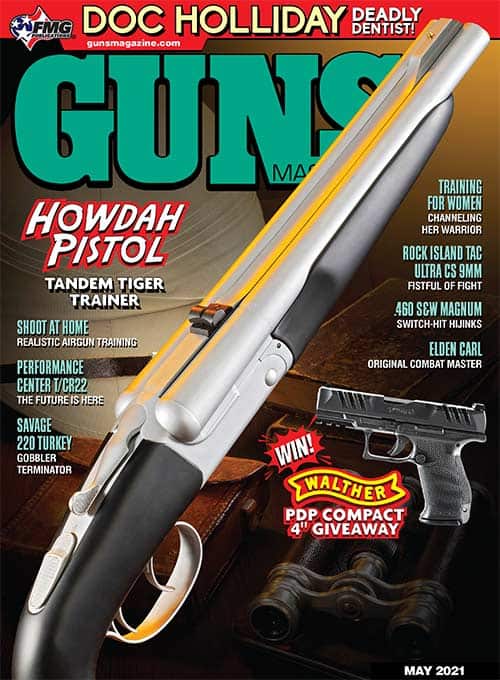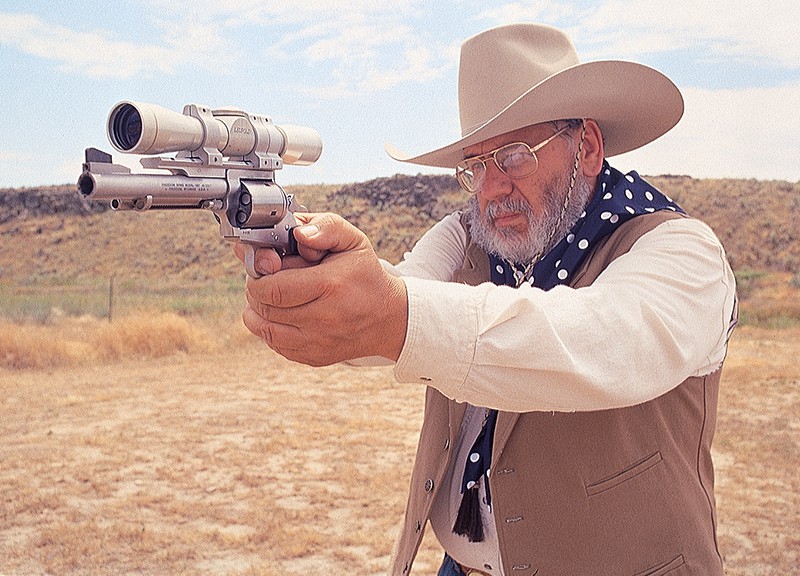Pedersoli Howdah
Built For The Final Charge
The breeze had stalled and the heat began to pound at the sweating men in the howdah. Their pith helmets were damp, hot and uncomfortable in the sun. The elephant’s gait jostled as they moved through the jungle trail. Sir Reginald Humphries, British Commanding Officer of Her Majesty’s troops in this part of India, his Batman, Wilkins and their mahout riding on the elephant’s neck were hunting tiger.
Or Was The Tiger Hunting Them?
“I don’t like it, I don’t like it at all,” muttered Sir Reginald. “Blast it, we had him and now he’s vanished like the ghost the villagers say he is. Keep the pistol handy, Wilkins.”
Wilkins held the Holland & Holland .577 Snider pistol, only introduced the year before in 1867, but Sir Reginald was known for having the best when it came to hunting. The short, fat, double barrels held the same cartridge as the Snider-Enfield military rifles. Its hefty 480-grain lead bullet carried a lethal sledgehammer-like blow at the muzzle-contact distance, the exact situation the Howdah pistol was created for. Indeed, shooting a rampaging tiger off the flanks of an elephant is something Sir Reginald had done before.
Wilkins hoped he didn’t have to do it today.
Sir Reginald signaled for the mahout to stop the elephant. A low, throaty, gravelly growl oozed from the thickness nearby.
“He’s too damn close, too close, blast him … I knew it. He’s hunting us now. Wilkins,” Sir Reginald’s hand reached out. “Hand me the pistol … quickly man!”
British Colonial Rule
During the 19th century, the British kept India on a short-leash and the country was filled with British officers on station along with monied British society men, all bent on hunting tigers and other game. They often hunted using the same techniques the local Rajas had used for generations — a howdah-equipped elephant.
The howdah was simply a platform securely held on an elephant’s back. They were sometimes built-up on the sides with protective barriers to keep tigers at bay. They could also be very elaborate, if royalty was hunting, or more utilitarian, as situations dictated.
The British were keen on “the hunt” and the strong British “bespoke” gunmakers like Westley Richards, Purdey, Holland & Holland, Manton, Rigby et. al kept them supplied with custom rifles, shotguns, handguns — and eventually, dedicated howdah pistols.
The first howdah pistols were simply cut-down military rifles, often worn-out guns with the barrels shot out. The toe-to-toe engagement distances battling tigers from the back of an elephant didn’t require much accuracy but as much stopping power as possible. The big bore military rifles of the time seemed perfect — but hunters soon found cutting a rifle down often left a poorly balanced tool, dangerous when response has to be lightning fast.
Enter The Howdah Pistol
Between 1835 and about 1850 Westley Richards made a very heavy single-barreled caplock pistol in .722 caliber specifically for defending your life in a howdah. As cartridge technology evolved, other makers got on board, chambering their various designs as muzzle loaders, then pinfires and eventually centerfires. The final iterations of the classic howdah are large bore centerfire cartridge guns, most often double barreled with external hammers. There are some without external hammers but they are rare.
I think the idea of the external hammers is to simplify things. You “know” the gun is cocked and ready when the hammers are back. Most had very rudimentary sights, often just a bead near the muzzle. We’re talking arm-distance or closer so no sights are really needed. Period hunting literature did make a point to say “… use extreme caution so the mahout is not killed, as then the elephant would be out of control.” Well … there’s that too.
Keep in mind, at the time, the only real alternative would have been Colt-style muzzle loading revolvers like the 1851 .36 cal. Navy or the various .44 designs, and European revolvers chambered in rim- or pin-fire cartridges of .38 or .45 caliber. None of them would have been very effective stopping a tiger intent on eating your mahout.
Enter Pedersoli
Why make a howdah today? Frankly, there’s no good reason at all, which makes it all the more unique, interesting and fun. The main reason is simply to enjoy a bit of what I think we can simply call “living” history. Why do we still make single action revolvers? Or single shot .22 rifles? Or any number of other antique designs? There’s no “need” for any of them and any plastic or aluminum platform will likely outperform the other designs — but we know the siren song of history beckons and one sure way to sing along is by using the guns of the day.
Pedersoli’s design has elements of the originals, blended with modern technology. I think had it been offered 150 years ago, it would have been chambered in a larger bore, centerfire rifle cartridge because I think the .45 Colt might be marginal when it comes to stopping charging tigers. We could argue loading it with a Buffalo Bore 300-grain hard cast bullet at 1,400 fps would do the job — and it likely would — but it’d not be the first thing I’d choose were I to step foot in a howdah today.
Nonetheless, it’s a delightful bit of whimsy to hold, shoot and experience. It’s all steel, with a hard-chrome finish and painted wood stocks, while the action is essentially two single-barreled pistols put together.
That was the whole idea of double rifles to begin with. Two barrels, two hammers, two triggers, two action springs — two separate rifles — just in case one broke at a critical moment.
Explanations
Chambered in .45 Colt, it’s actually bored to also chamber .410 shotgun shells. Barrels are 10.25″ and rifled, keeping it out of the “short barreled shotgun” category. It’s about 17″ long, weighing a bit more than 4 lbs. empty. It’s got a brass bead front and a sort of simple “V” notch rear blade assembly. The triggers each control one barrel and yes — you can shoot them simultaneously if you like. It’s actually not very dramatic due to the weight.
The safety is on the tang and comfy to use. Once broken open with the side-lever on top, cartridges or shotgun shells chamber easily and extract the same way. The edges are a bit sharp on the ejector as is the case with many Italian guns and I’d stone them a touch if I were keeping it — but it was only something I noticed and didn’t affect usability at all.
Overall workmanship is top-notch and parts fit as well as you could expect. I think the black-painted stock is a matter of taste and while it does look “tactical” with the hard chrome, I’d like it more left as natural walnut. Your taste may vary though.
Accuracy?
Well now, I’m not quite sure if it matters. While British officers were known to take their howdah pistols into battle at times, distances even then would be measured in feet. Since this gun is simply made for fun, I’d say the same applies. Could you use it for home defense or some such? Well, of course, just like you could use a club or a spear in a pinch, but there are better tools to rely on. The howdah is heavy, awkward to hold in one hand and the manual of arms to load it is a bit fussy.
The “break-open” takes two hands and firm grips and I found a strike on my thigh helped to break it open expeditiously. You need to extract the empties, re-load each barrel, close it down (two hands again), make sure the safety is off, try to aim the beast — I used my off-hand on the fore-stock — then remember to pull two different triggers. Repeat as needed. Give me a Charter Arms .38 any day if things were serious.
But — and this is the big one — it’s absolutely nearly as much fun as law allows, plus it raises eyes to high heaven when people see it. “What the bajesus is that thing!?” they say. “It’s a howdah pistol,” you say smiling. “A what?” they say, eyebrows raised. Then the game is afoot. It’s fun, trust me.
Out of curiosity more than any sense of practical use, I bag-rested the howdah at 15 yards. Using Black Hills factory .45 Colt cowboy loads that were handy, recoil was virtually zero. Even heavy 300-grain hunting loads barely caused a stir.
The right barrel, aimed at the target’s center, sent three of the rounds into a nice, 1″ group about 6″ high and centered, then tossed two into the bull area but just to the right a couple of inches. Oddly enough, the left barrel also hit about 6″ high, but the group was a nicely rounded 3.5″ and about 3″ to the left. The bead sight does make things a bit guessy but I strove to be consistent.
I repeated the drill several times and it always worked out the same. The right barrel would shoot a few into a group, then randomly toss a couple into another spot. The left sent them into the same area all the time. But who cares? I predict if Sir Reginald fired it, he’d pronounce it “Bloody fine, but don’t you have one in a serious caliber, lad?”
Make this in .45-70 and possibly better sights just for the helluvit and you might have just invented a new fun gun, especially if the barrels can be regulated a bit tighter.
And?
Yes, it’s a winner. At about $1,395 give or take, it’s not cheap but it’s not too expensive. You could spend this on a nice, modern polymer fancy-auto and exactly nobody would give it a second glance at the range. Spend the same amount on the howdah and be prepared to be inundated with questions, pitches to shoot it — “Oh, please!” — and the stares of people who don’t know quite what to think. All the more reason to wear a pith helmet when you shoot it. “Oh, he must be English?”
And, if you get attempted borders en route home from the range, you can repel the savage brutes in high fashion.
Just don’t shoot your mahout.












